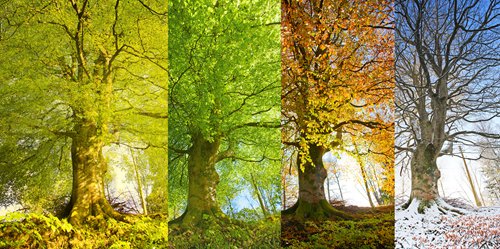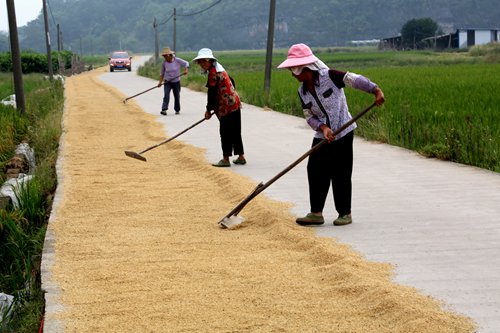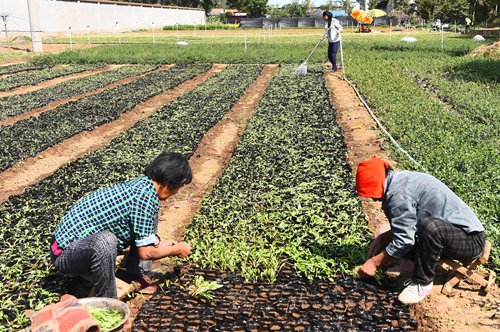The world has seen great technological advancement in just the past few decades. The 24 solar terms, a thousand-year-old calendar system used by Chinese farmers to plant and harvest crops, seems to be losing its attractiveness among younger generations who now rely heavily on electronic devices.

An adult and child along a riverbank Photos: CFP
Phenophases, philosophies and phenomena
Each solar term on the almanac-like calendar has a specific name representing a feature of that specific period. For example, Grain in Beard usually comes on June 5, 6 or 7, when farmers are busy with harvest or planting new seeds. The End of Heat on August 22, 23 or 24 tells people that the hottest weather of the year has passed.
One day, perhaps people will only remember that, when the Winter Solstice (one of the 24 solar terms) arrives on December 21, 22 or 23 every year, we need to eat dumplings to protect our ears from being stung with cold - a traditional tale that prevails in North China.
The preserving and passing of the 24 solar terms of China has become a serious issue among traditionalists in the digital era, but good news arrived last November when China's 24 solar terms were finally listed as Intangible Cultural Heritage of Humanity by the United Nations Educational, Scientific and Cultural Organization (UNESCO).
Soon afterward, the China Folklore Society constructed a studying center of China's 24 solar terms in Beijing, aiming to explore folklore resources behind the terms in different areas while protecting and passing down the heritage for future generations.

Trees during different seasons
Interview with Huang Jingchun
Huang Jingchun, deputy director of the new studying center and a professor specializing folklore and ancient Chinese literature at Shanghai University, recently sat down with the Global Times to share his knowledge and ideas about the protection of the 24 solar terms in China.
GT: Ancient Chinese people used both the lunar calendar and solar calendar. What are their respective functions?
Huang: The Chinese traditional calendar is actually called the "lunisolar" calendar by scholars. To make it distinct from the Gregorian calendar created by the Westerners, Chinese people used to name it in different ways, such as Chinese calendar (pronounced as zhongli in Putonghua), ancient calendar (jiuli) and lunar calendar (yinli). However, a lunar calendar, indicating only the moon phases, is actually incorrect, as the Chinese traditional calendar combines both lunar calendar and solar calendar.
Solar calendars decide the first day of a new year, months and festivals according to the movement of the sun on the ecliptic. Lunar calendars set months and dates based on the position of the moon on its revolution around Earth. To make the lunar months of lunisolar calendars align with the solar year, Chinese add an intercalated month every three years.
We call the Chinese traditional calendar "lunisolar" mainly because it is imbedded with the 24 solar terms, which are defined according to the position of the sun. The 24 solar terms actually reflects the position of Earth revolving around the sun. Every 15-degree movement makes one term and 360 degrees make 24 terms, which means a solar year.
As Earth revolves around the sun in an ellipse, it rotates faster on its axis when it comes closer to the sun and slower when it goes farther. Therefore, it takes Earth 15 days, sometimes 14 or 16 days, to finish one term. The terms can reflect the climate changes of different seasons correctly. Therefore, it is a solar calendar.
GT: The 24 solar terms were established before the Qin Dynasty (221BC-206BC). Has it ever gone through any evolution in the past thousand years?
Huang: The 24 solar terms have undergone some changes. In the Xiaozheng Chinese Calendar, one of China's oldest scientific documents completed during the Spring and Autumn Period (770BC-476BC), there were some descriptions on phenological phenomena and farm works which were used to guide agricultural activities and identical to the ideas to the 24 solar terms.
In the later stages of the Warring States (475BC-221BC), the Lü's Annals, Twelve Periods, a series documents telling phenological changes and Taoism philosophies, included eight solar terms among which the Beginning of Spring (February 3, 4 or 5), the Beginning of Summer (May 5, 6 or 7), the Beginning of Autumn (August 7, 8 or 9), the Beginning of Winter (November 7 or 8) mark the starting of four seasons, while the Spring Equinox (March 20, 21 or 22), the Summer Solstice (June 21 or 22), the Autumnal Equinox (September 22, 23 or 24) and the Winter Solstice stay in the middle of the four seasons.
At the beginning of Western Han Dynasty (206BC-AD25), the Huainanzi, a philosophical work of the Eclectics of ancient China, made a detailed description of the 24 solar terms. Later on, Emperor Wu (156BC-87BC) of the Han Dynasty integrated the terms into the solar calendar, from when the terms became an indispensable part of Chinese calendars.
GT: Some people argue that the terms are no longer accurate due to climate changes. What do you think?
Huang: The 24 solar terms are still important, as they reflect the changes of seasons and the phenophases and are used to guide agricultural production. As they were concluded in the mid and lower reaches of the Yellow River, it is suitable for that area.
Farmers in different geographical latitudes consult the terms based on specific local conditions. This can be explained by some farming proverbs. For instance, farmers in Central China's Henan Province say that the Autumnal Equinox (September 22, 23 or 24) is the best time to sow wheat, those in Central China's Hubei Province believe that Cold Dew (October 8 or 9) is the best choice, but people in East China's Zhejiang Province prefer the Frost's Descent (October 23 or 24).
Climate change is not so serious yet to affect actual seasons. China is a vast territory. The terms might be poorly applicable in Northeast China and South China including South China's Guangdong Province and the Guangxi Zhuang Autonomous Region, but it won't affect the division of the four seasons by the four beginnings, two equinoxes and two solstices. Currently, they can still direct agricultural production in the areas of the Yellow and Yangtze rivers.
GT: Most modern people's understanding of the terms is quite limited. How can we protect the terms, as they are now listed as an intangible cultural heritage of China?
Huang: It is true that some people understand the terms in a superficial way and even regard them as an outdated or superstitious calendar. We should self-question the superstitious beliefs people have endowed to the terms, such as taboos on particular days. However, the most important thing is that we need to understand it in an accurate and correct way and keep in mind that it is a solar calendar in essence.
The Gregorian calendar is only a solar calendar, which only considers the position of the sun. The calendar of Islam is a lunar calendar which includes 12 lunar months but does not consider the tropical year. The Chinese traditional calendar integrating both the tropical year and 12 lunar months bears the exploration spirit and wisdom of ancient Chinese.
GT: As urbanization progresses along with technological advancement, what kind of meaning do the terms have?
Huang: The terms has been closely combined with the living rhythm, lifestyle and especially traditional festivals of Chinese people. It also absorbed some contents of history, religions and folklore. These cultural features are still playing an energetic role in our society despite increasing urbanization.
For example, people are now emphasizing more on health, which requires us to understand the knowledge of the terms. It is not only a cultural heritage of China, but also a precious heritage to all the human beings.
GT: How will your center spread and promote the terms in the future?
Huang: In fact, there has been a fever to protect the terms after they were listed as a UNESCO intangible cultural heritage. The establishment of the center is a practical step that the China Folklore Society took to bring together folklorists, historians and experts studying cultural relics and calendars to protect and promote the terms.
Some organizations have been set up to protect some or all of the terms. Creations themed with the terms are so active that thousands of paintings, especially peasant paintings, have been made.
The center will get more involved in the protection activities held in different places and organize studying workshops to delve into the cultural essence. Forums co-organized by the academic field and local governments such as the one held by Nanjing Agricultural University and Gaochun county of East China's Jiangsu Province on September 23 are also an important way by which the scholars could do research on the basis of local agricultural production and history.

Farmers harvest rice in autumn.

Flower farmers transplant flowers.
